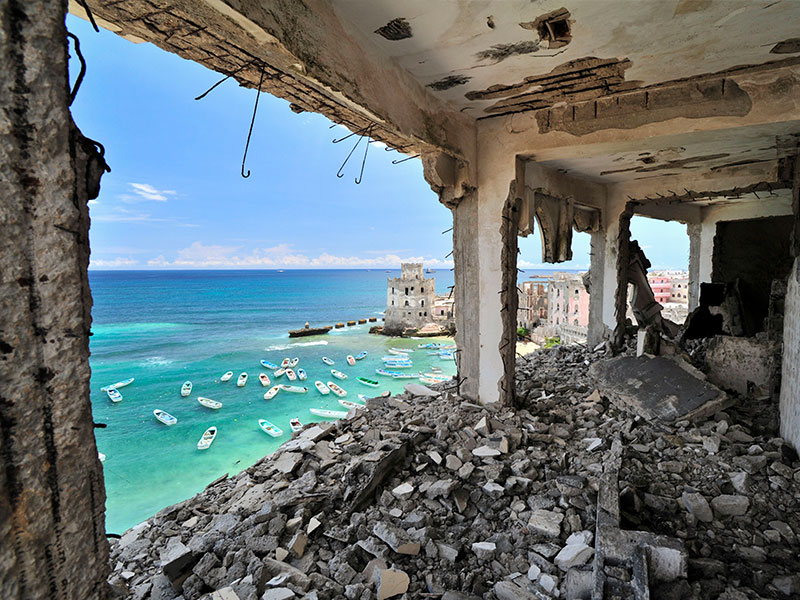Michael Lodge, NCPM, CRTP: We are currently seeing an aggressive war brought on by Putin and his plan to expand Russia to what it was before the break up into smaller nations. This includes Ukraine, Poland and many other countries. As we watch what he is doing, going into Ukraine - unprovoked by Ukraine, his destroying of towns and villages, the killing of innocent individuals, we may have cause for a war crime against Putin an the Military performing the crimes. This is a very serious situation. In review of these "war crimes" descriptions, and looking at what we are seeing in Ukraine by Putin and his military, there is just cause to charge these individuals with war crimes charges. The United States and every free nation should be asking the United Nations and the courts to begin cases on Putin and his military - top down.
Background
 Ruins of Al-Uruba Hotel, Mogadishu
Ruins of Al-Uruba Hotel, Mogadishu
UN Photo/Tobin Jones
Even though the prohibition of certain behavior in the conduct of armed conflict can be traced back many centuries, the concept of war crimes developed particularly at the end of the 19th century and beginning of the 20th century, when international humanitarian law, also known as the law of armed conflict, was codified. The Hague Conventions adopted in 1899 and 1907 focus on the prohibition to warring parties to use certain means and methods of warfare. Several other related treaties have been adopted since then. In contrast, the Geneva Convention of 1864 and subsequent Geneva Conventions, notably the four 1949 Geneva Conventions and the two 1977 Additional Protocols, focus on the protection of persons not or no longer taking part in hostilities. Both Hague Law and Geneva Law identify several of the violations of its norms, though not all, as war crimes. However there is no one single document in international law that codifies all war crimes. Lists of war crimes can be found in both international humanitarian law and international criminal law treaties, as well as in international customary law.
The 1949 Geneva Conventions have been ratified by all Member States of the United Nations, while the Additional Protocols and other international humanitarian law treaties have not yet reached the same level of acceptance. However, many of the rules contained in these treaties have been considered as part of customary law and, as such, are binding on all States (and other parties to the conflict), whether or not States have ratified the treaties themselves. In addition, many rules of customary international law apply in both international and non-international armed conflict, expanding in this way the protection afforded in non-international armed conflicts, which are regulated only by common article 3 of the four Geneva Conventions and Additional Protocol II.
Definition
Rome Statute of the International Criminal Court
Article 8
War Crimes
The Court shall have jurisdiction in respect of war crimes in particular when committed as part of a plan or policy or as part of a large-scale commission of such crimes.
For the purpose of this Statute, ‘war crimes’ means:
Grave breaches of the Geneva Conventions of 12 August 1949, namely, any of the following acts against persons or property protected under the provisions of the relevant Geneva Convention:
Wilful killing
Torture or inhuman treatment, including biological experiments;
Wilfully causing great suffering, or serious injury to body or health;
Extensive destruction and appropriation of property, not justified by military necessity and carried out unlawfully and wantonly;
Compelling a prisoner of war or other protected person to serve in the forces of a hostile Power;
Wilfully depriving a prisoner of war or other protected person of the rights of fair and regular trial;
Unlawful deportation or transfer or unlawful confinement;
Taking of hostages.
Other serious violations of the laws and customs applicable in international armed conflict, within the established framework of international law, namely, any of the following acts:
Intentionally directing attacks against the civilian population as such or against individual civilians not taking direct part in hostilities;
Intentionally directing attacks against civilian objects, that is, objects which are not military objectives;
Intentionally directing attacks against personnel, installations, material, units or vehicles involved in a humanitarian assistance or peacekeeping mission in accordance with the Charter of the United Nations, as long as they are entitled to the protection given to civilians or civilian objects under the international law of armed conflict;
Intentionally launching an attack in the knowledge that such attack will cause incidental loss of life or injury to civilians or damage to civilian objects or widespread, long-term and severe damage to the natural environment which would be clearly excessive in relation to the concrete and direct overall military advantage anticipated;
Attacking or bombarding, by whatever means, towns, villages, dwellings or buildings which are undefended and which are not military objectives;
Killing or wounding a combatant who, having laid down his arms or having no longer means of defence, has surrendered at discretion;
Making improper use of a flag of truce, of the flag or of the military insignia and uniform of the enemy or of the United Nations, as well as of the distinctive emblems of the Geneva Conventions, resulting in death or serious personal injury;
The transfer, directly or indirectly, by the Occupying Power of parts of its own civilian population into the territory it occupies, or the deportation or transfer of all or parts of the population of the occupied territory within or outside this territory;
Intentionally directing attacks against buildings dedicated to religion, education, art, science or charitable purposes, historic monuments, hospitals and places where the sick and wounded are collected, provided they are not military objectives;
Subjecting persons who are in the power of an adverse party to physical mutilation or to medical or scientific experiments of any kind which are neither justified by the medical, dental or hospital treatment of the person concerned nor carried out in his or her interest, and which cause death to or seriously endanger the health of such person or persons;
Killing or wounding treacherously individuals belonging to the hostile nation or army;
Declaring that no quarter will be given;
Destroying or seizing the enemy's property unless such destruction or seizure be imperatively demanded by the necessities of war;
Declaring abolished, suspended or inadmissible in a court of law the rights and actions of the nationals of the hostile party;
Compelling the nationals of the hostile party to take part in the operations of war directed against their own country, even if they were in the belligerent's service before the commencement of the war;
Pillaging a town or place, even when taken by assault;
Employing poison or poisoned weapons;
Employing asphyxiating, poisonous or other gases, and all analogous liquids, materials or devices;
Employing bullets which expand or flatten easily in the human body, such as bullets with a hard envelope which does not entirely cover the core or is pierced with incisions;
Employing weapons, projectiles and material and methods of warfare which are of a nature to cause superfluous injury or unnecessary suffering or which are inherently indiscriminate in violation of the international law of armed conflict, provided that such weapons, projectiles and material and methods of warfare are the subject of a comprehensive prohibition and are included in an annex to this Statute, by an amendment in accordance with the relevant provisions set forth in articles 121 and 123;
Committing outrages upon personal dignity, in particular humiliating and degrading treatment;
Committing rape, sexual slavery, enforced prostitution, forced pregnancy, as defined in article 7, paragraph 2 (f), enforced sterilization, or any other form of sexual violence also constituting a grave breach of the Geneva Conventions;
Utilizing the presence of a civilian or other protected person to render certain points, areas or military forces immune from military operations;
Intentionally directing attacks against buildings, material, medical units and transport, and personnel using the distinctive emblems of the Geneva Conventions in conformity with international law;
Intentionally using starvation of civilians as a method of warfare by depriving them of objects indispensable to their survival, including wilfully impeding relief supplies as provided for under the Geneva Conventions;
Conscripting or enlisting children under the age of fifteen years into the national armed forces or using them to participate actively in hostilities.
In the case of an armed conflict not of an international character, serious violations of article 3 common to the four Geneva Conventions of 12 August 1949, namely, any of the following acts committed against persons taking no active part in the hostilities, including members of armed forces who have laid down their arms and those placed hors de combat by sickness, wounds, detention or any other cause:
Violence to life and person, in particular murder of all kinds, mutilation, cruel treatment and torture;
Committing outrages upon personal dignity, in particular humiliating and degrading treatment;
Taking of hostages;
The passing of sentences and the carrying out of executions without previous judgement pronounced by a regularly constituted court, affording all judicial guarantees which are generally recognized as indispensable.
Paragraph 2 (c) applies to armed conflicts not of an international character and thus does not apply to situations of internal disturbances and tensions, such as riots, isolated and sporadic acts of violence or other acts of a similar nature.
Other serious violations of the laws and customs applicable in armed conflicts not of an international character, within the established framework of international law, namely, any of the following acts:
Intentionally directing attacks against the civilian population as such or against individual civilians not taking direct part in hostilities;
Intentionally directing attacks against buildings, material, medical units and transport, and personnel using the distinctive emblems of the Geneva Conventions in conformity with international law;
Intentionally directing attacks against personnel, installations, material, units or vehicles involved in a humanitarian assistance or peacekeeping mission in accordance with the Charter of the United Nations, as long as they are entitled to the protection given to civilians or civilian objects under the international law of armed conflict;
Intentionally directing attacks against buildings dedicated to religion, education, art, science or charitable purposes, historic monuments, hospitals and places where the sick and wounded are collected, provided they are not military objectives;
Pillaging a town or place, even when taken by assault;
Committing rape, sexual slavery, enforced prostitution, forced pregnancy, as defined in article 7, paragraph 2 (f), enforced sterilization, and any other form of sexual violence also constituting a serious violation of article 3 common to the four Geneva Conventions;
Conscripting or enlisting children under the age of fifteen years into armed forces or groups or using them to participate actively in hostilities;
Ordering the displacement of the civilian population for reasons related to the conflict, unless the security of the civilians involved or imperative military reasons so demand;
Killing or wounding treacherously a combatant adversary;
Declaring that no quarter will be given;
Subjecting persons who are in the power of another party to the conflict to physical mutilation or to medical or scientific experiments of any kind which are neither justified by the medical, dental or hospital treatment of the person concerned nor carried out in his or her interest, and which cause death to or seriously endanger the health of such person or persons;
Destroying or seizing the property of an adversary unless such destruction or seizure be imperatively demanded by the necessities of the conflict;
Paragraph 2 (e) applies to armed conflicts not of an international character and thus does not apply to situations of internal disturbances and tensions, such as riots, isolated and sporadic acts of violence or other acts of a similar nature. It applies to armed conflicts that take place in the territory of a State when there is protracted armed conflict between governmental authorities and organized armed groups or between such groups.
Nothing in paragraph 2 (c) and (e) shall affect the responsibility of a Government to maintain or re-establish law and order in the State or to defend the unity and territorial integrity of the State, by all legitimate means.
Elements of the Crime
War crimes are those violations of international humanitarian law (treaty or customary law) that incur individual criminal responsibility under international law. As a result, and in contrast to the crimes of genocide and crimes against humanity, war crimes must always take place in the context of an armed conflict, either international or non-international.
What constitutes a war crime may differ, depending on whether an armed conflict is international or non-international. For example, Article 8 of the Rome Statute categorizes war crimes as follows:
Grave breaches of the 1949 Geneva Conventions, related to international armed conflict;
Other serious violations of the laws and customs applicable in international armed conflict;
Serious violations of Article 3 common to the four 1949 Geneva Conventions, related to armed conflict not of an international character;
Other serious violations of the laws and customs applicable in armed conflict not of an international character.
From a more substantive perspective, war crimes could be divided into: a) war crimes against persons requiring particular protection; b) war crimes against those providing humanitarian assistance and peacekeeping operations; c) war crimes against property and other rights; d) prohibited methods of warfare; and e) prohibited means of warfare.
Some examples of prohibited acts include: murder; mutilation, cruel treatment and torture; taking of hostages; intentionally directing attacks against the civilian population; intentionally directing attacks against buildings dedicated to religion, education, art, science or charitable purposes, historical monuments or hospitals; pillaging; rape, sexual slavery, forced pregnancy or any other form of sexual violence; conscripting or enlisting children under the age of 15 years into armed forces or groups or using them to participate actively in hostilities.
War crimes contain two main elements:
A contextual element: “the conduct took place in the context of and was associated with an international/non-international armed conflict”;
A mental element: intent and knowledge both with regards to the individual act and the contextual element.
In contrast to genocide and crimes against humanity, war crimes can be committed against a diversity of victims, either combatants or non-combatants, depending on the type of crime. In international armed conflicts, victims include wounded and sick members of armed forces in the field and at sea, prisoners of war and civilian persons. In the case of non-international armed conflicts, protection is afforded to persons taking no active part in the hostilities, including members of armed forces who have laid down their arms and those placed ‘hors de combat’ by sickness, wounds, detention, or any other cause. In both types of conflicts protection is also afforded to medical and religious personnel, humanitarian workers and civil defense staff.
https://www.un.org/en/genocideprevention/war-crimes.shtml

